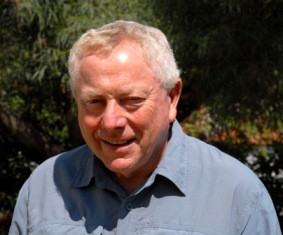Out with Papa-figos

Clive Viney - co-author of Algarve Wildlife - the natural year
Papa-figos (which literally translates as fig eater) is the Portuguese name for the Golden Oriole, one of the iconic visiting birds of the Algarve. Clive Viney is the co-author of Algarve Wildlife - the natural year, and now, under the guise of Papa-Figos, chronicles his finds, thoughts and feelings while walking in the Algarve countryside throughout the natural year. Look out for his regular updates, illustrated by his fellow co-author and photographer, Ray Tipper, who has kindly provided some of the photographs that illustrate these articles by clicking through from the links below.
Pego do Inferno RIP

Pego do Inferno
When I first came to Tavira in the eighties Pego do Inferno was known by locals as the ‘secret waterfall’. A large, deep pool beneath the waterfall provided a wonderful alternative to sea bathing. Few people and a long walk meant that it was a pristine spot. The name literally meant Hell’s Pool due to a legend about a carriage that fell into the pool and was never found. It was said that anyone who fell into the pool would go straight to hell.

Silver Gorse
Gaynor Stapleton mentioned that whilst out horse riding she had discovered a small barragem near Pego do Inferno that was very birdy. On this grey mid December morning I decided to go and look for that lake. In this off-the-beaten locality I parked next to a small French-plated car with a black brassiere hanging from a wing mirror. I followed a track up the east side of the valley through citrus orchards. Eventually I crossed the Ribeira da Assêca and joined the surfaced road down the west side of the valley. When I returned to the Discovery, a friendly young couple and a large dog had emerged from the car. Although I was fairly close to the river for most of the walk there was no sign of a barragem and the flow was surprisingly moderate.

Strawberry Tree
Whilst taking coffee from my flask, Gaynor and a companion clip-clopped to stop and explained that I’d gone in completely the wrong direction and said that the barragem was close-by but on the other side of a hill. I went up the track with a dead-end sign. Just past two houses the track split. The right track led down to the fast-flowing Ribeira de Alportel; just before the confluence below Pego do Inferno. The left track eventually split and the left fork along the hillside led to a point overlooking a small reedy irrigation reservoir amid citrus groves. It was possible to drop down and view the reservoir from the dam. Just a female and two drake Mallards and Moorhens calling but it was a delightful spot and worth visiting. Silver Gorse and blossoming Strawberry Trees were showing well and I photographed a splendid mushroom that was later identified by Pat O’Reilly as Stubble Rosegill Volvariella gloiocephalus.

Stubble Rosegill
I was in pioneering mode and birding was not the main priority. Nevertheless, there were plenty of Eurasian Jays, Iberian Azure-winged Magpies, Hoopoes, Red-legged Partridges, Crag Martins and a Common Buzzard patrolled the valley.
Gaynor had warned that Pego do Inferno had been (literally) turned off and in any event it was now impossible to reach. This I confirmed. A few years ago the Tavira Câmara spent a fortune (probably funded by an EU grant) to provide elaborate access paths, fencing, a footbridge, information boards and even platforms for storks to, hopefully, breed on but to the disappointment of most discouraged swimming in the beautiful pool. Car parks were also built and no doubt a contractor or two made a tidy profit. Even a seasonal drinks stall appeared. Before then, as there was nowhere to park, everybody walked up the riverbed or across the fields to reach the waterfall. In 2012, a hill fire damaged the new infrastructure but seemingly there was no maintenance vote and everything began to fall apart. Frustrated swimmers created their own access and vandalism became a factor but still nothing was done to repair this prime tourist attraction (look it up on TripAdvisor or Google). At the end of the 2015 season I visited and plenty of people were still swimming but access was becoming even more difficult and as the Câmara had abandoned the area litter was everywhere. I felt sure that during the off season repairs would be put in hand but today there was nothing left and the area had become very dangerous to enter. Accordingly, water had been diverted and Pego do Inferno no longer existed.
A cold, bone-chilling mist had begun to embrace the valley, so I headed for home.

